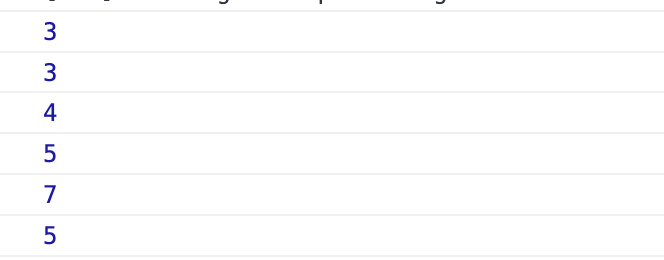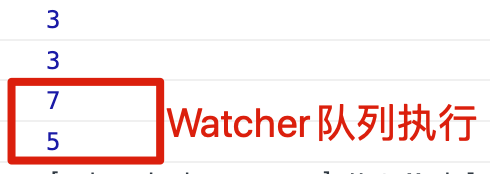Vue2剝絲抽繭-響應式系統之異步隊列
Vue2 源碼從零詳解系列文章, 還沒有看過的同學可能需要看一下之前的,vue.windliang.wang。
場景
import { observe } from "./reactive";
import Watcher from "./watcher";
const data = {
a: 1,
b: 2,
c: 3,
};
observe(data);
const updateComponent = () => {
console.log(data.a + data.b);
};
new Watcher(updateComponent);
const updateComponent2 = () => {
console.log(data.c);
};
new Watcher(updateComponent2);
data.a = 2;
data.a = 3;
data.b = 4;
data.c = 5;
new Watcher(updateComponent) 進行依賴收集會輸出一次 3 ,new Watcher(updateComponent2) 進行依賴收集也會輸出一次 3 。
之后我們依次改變 a、 a 、b、c 的值,每改變一次就會觸發 Watcher 的執行,會連續進行四次的 console.log。

試想一下如果這里的 console.log 是渲染頁面,那改變一次值就刷新一下頁面,會造成嚴重的性能問題,頁面也會不停的改變。
解決方案
我們可以通過一個隊列,收集所有的 Watcher 。
那什么時候執行 Watcher 隊列呢?
為了等所有的 Watcher 都收集完畢,可以將 Watcher 的執行放到 setTimeout 中。這樣當主線程全部執行后,才會去執行 Watcher 隊列。
代碼實現
我們可以給每一個 Watcher 加上一個 id,如果隊列中已經有 id 了就不加入隊列。
let uid = 0;
export default class Watcher {
constructor(Fn, options) {
this.getter = Fn;
this.depIds = new Set(); // 擁有 has 函數可以判斷是否存在某個 id
this.deps = [];
this.newDeps = []; // 記錄新一次的依賴
this.newDepIds = new Set();
/******新增 *************************/
this.id = ++uid; // uid for batching
// options
if (options) {
this.sync = !!options.sync;
}
/************************************/
this.get();
}
...
}
我們同時提供了一個 options 對象,保存了其中的 sync 字段,表示是像之前一樣立即出觸發 Watcher 還是放到隊列中。
然后 Watcher 的 update 方法中我們去調用加入隊列的函數。
export default class Watcher {
...
update() {
if (this.sync) {
this.run(); // 直接運行
} else {
queueWatcher(this); // 加入隊列
}
}
...
}
看一下 queueWatcher 的實現。
const queue = []; // 保存 Watcher 隊列
let has = {}; // 去重 Watcher
let waiting = false; // 是否加入到了 setTimeout 隊列
export function queueWatcher(watcher) {
const id = watcher.id;
if (has[id] == null) {
has[id] = true;
queue.push(watcher); // 加入隊列
// queue the flush
if (!waiting) { // 執行 Watcher 函數放到 setTimeout 隊列中,只加入一次即可
waiting = true;
setTimeout(flushSchedulerQueue, 0);
}
}
}
再看一下上邊執行 Watcher 隊列的 flushSchedulerQueue 函數的實現。
let flushing = false; // 是否正在執行隊列
let index = 0;
/**
* Flush both queues and run the watchers.
*/
function flushSchedulerQueue() {
flushing = true;
let watcher, id;
for (index = 0; index < queue.length; index++) {
watcher = queue[index];
id = watcher.id;
has[id] = null;
watcher.run();
}
resetSchedulerState(); // 執行結束后進行重置
}
/**
* Reset the scheduler's state.
*/
function resetSchedulerState() {
index = queue.length = 0;
has = {};
waiting = flushing = false;
}
總體上就是上邊的樣子了。
執行結果
import { observe } from "./reactive";
import Watcher from "./watcher";
const data = {
a: 1,
b: 2,
c: 3,
};
observe(data);
const updateComponent = () => {
console.log(data.a + data.b);
};
new Watcher(updateComponent);
const updateComponent2 = () => {
console.log(data.c);
};
new Watcher(updateComponent2);
data.a = 2;
data.a = 3;
data.b = 4;
data.c = 5;
雖然后邊我們改變了四次 data 中的值,但事實上只有兩個 Watcher ,因此只會輸出兩次。

總結
通過異步的一個隊列,當所有 Watcher 收集完畢后統一執行,進行了性能方面的優化。








































